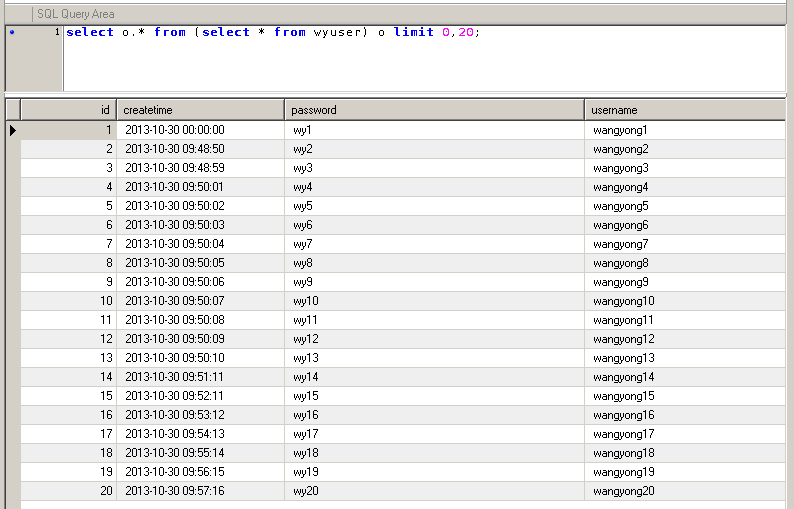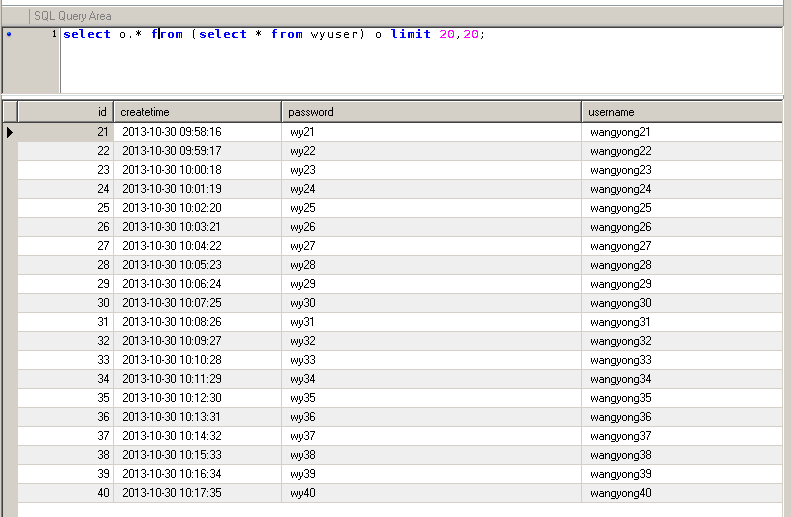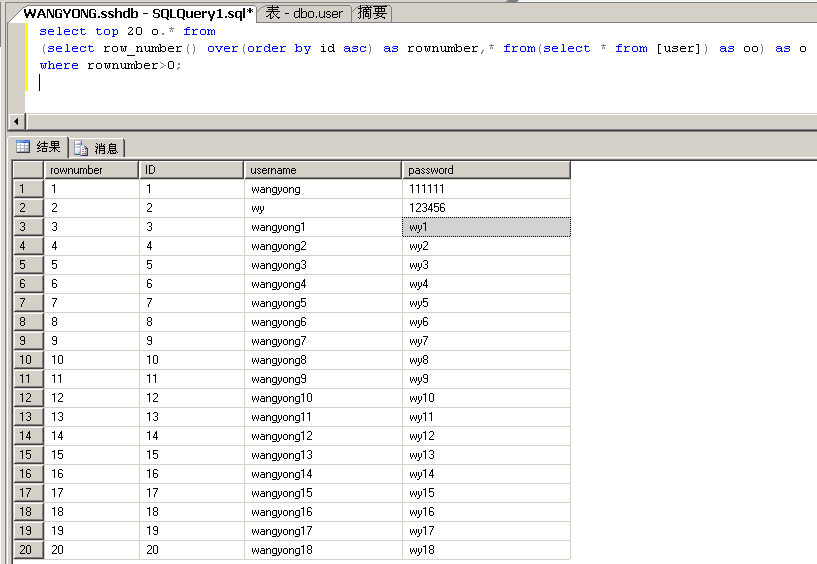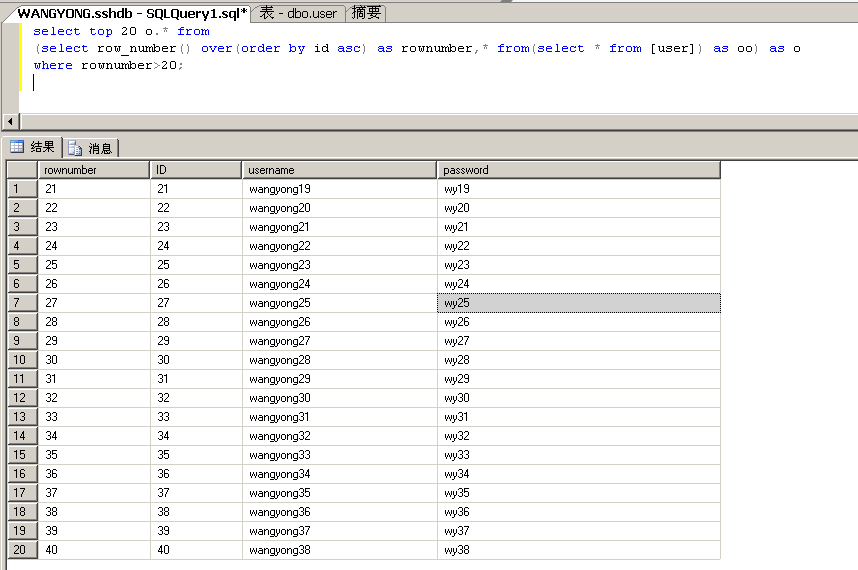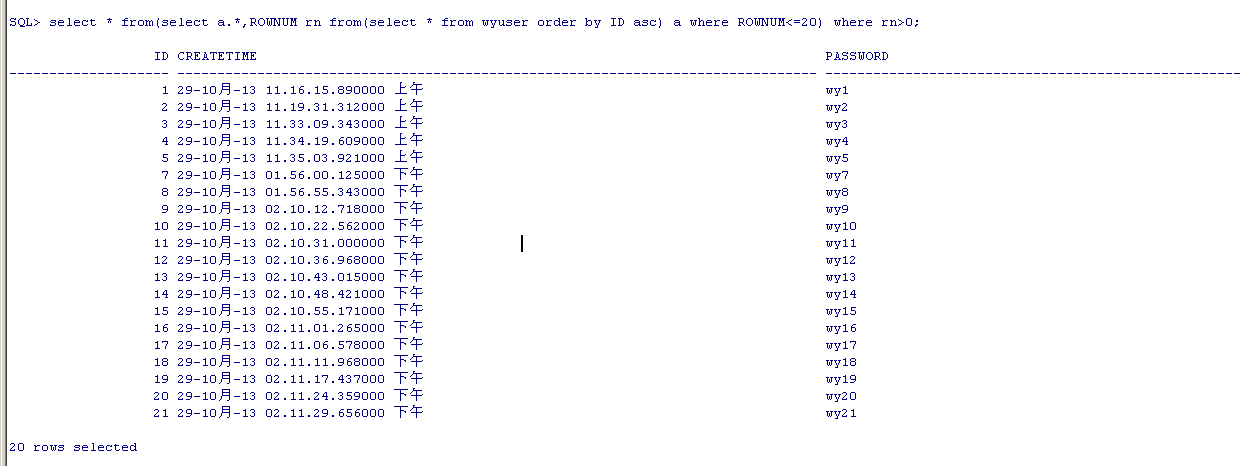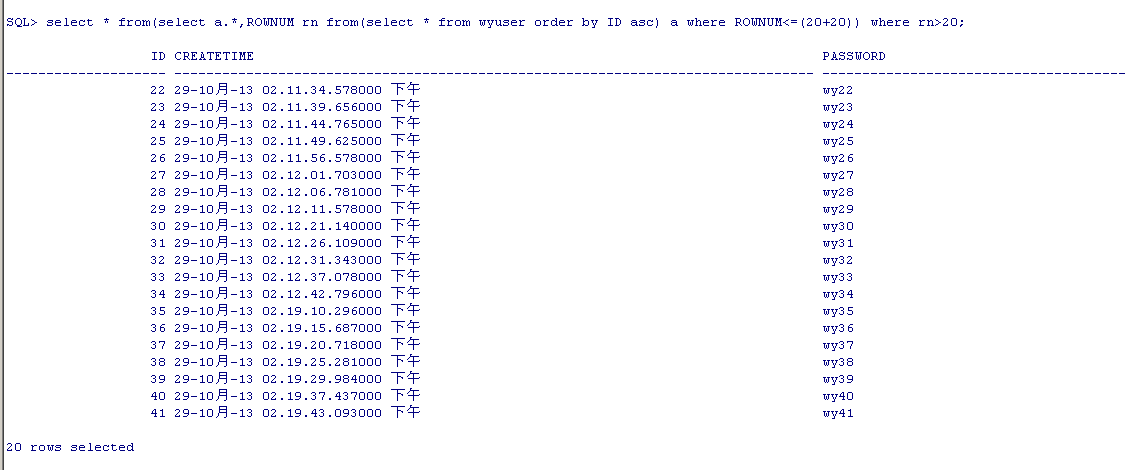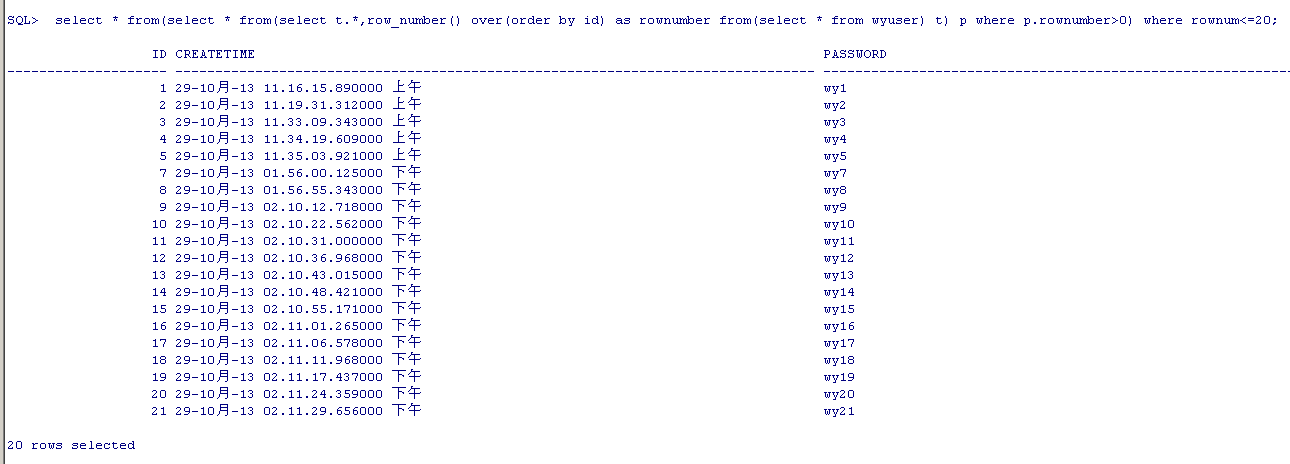oracle,mysql,sqlserver分頁查詢,附實體類
最近簡單的對oracle,mysql,sqlserver2005的資料分頁查
(一)、 mysql的分頁查詢
mysql的分頁查詢是最簡單的,藉助關鍵字limit即可實現查詢,查詢語句通式:
/* * sql:可以是單表的查詢語句,也可以是多表的聯合查詢語句 * firstIndex:其實的索引 * pageSize:每頁顯示的記錄數 */ select o.* from (sql) o limit firstIndex,pageSize
如下面的截圖,每頁顯示的記錄數為20:
查詢(1-20)這20條記錄
查詢(21-40)這20條記錄
mysql的分頁查詢就這麼簡單......
(二)、sqlserver2005的分頁查詢
在sqlserver2005之前一直藉助top關鍵字來實現分頁查詢,不過效率低,在sqlserver2005及其之後的版本都使用row_number()解析函式來完成分頁查詢,效率有了很大的提高,不過sql語句比較複雜,下面給出分頁查詢的通式:
/*
* firstIndex:起始索引
* pageSize:每頁顯示的數量
* orderColumn:排序的欄位名
* sql:可以是簡單的單表查詢語句,也可以是複雜的多表聯合查詢語句
*/
select top pageSize o.* from (select row_number() over(order by orderColumn) as rownumber,* from(sql) as o where rownumber>firstIndex;下面看截圖,每頁顯示20條記錄數:
查詢(1-20)這20條記錄
查詢(21-40)這20條記錄
知道了sqlserver中的row_number函式,分頁也就簡單了.....
(三)、oracle分頁查詢
接下來重點說說oracle的分頁查詢,oracle的分頁查詢方法相對來說要多點,ROWNUM、row_number(),今天主要將兩種效率稍好的分頁查詢語句。
①ROWNUM查詢分頁通式:
/*
* firstIndex:起始索引
* pageSize:每頁顯示的數量
* sql:可以是簡單的單表查詢語句,也可以是複雜的多表聯合查詢語句
*/
select * from(select a.*,ROWNUM rn from(sql) a where ROWNUM<=(firstIndex+pageSize)) where rn>firstIndex以下截圖是以這種方式進行的查詢語句:
查詢(1-21)這20條記錄*****(沒有ID=6的記錄,所以查詢到的最大ID為21)
查詢(22-41)這20條記錄*****(沒有ID=6的記錄,所以開始查詢到的ID為22,以及最大ID為41)
②row_number()解析函式分頁查詢通式:
/*
* firstIndex:起始索引
* pageSize:每頁顯示的數量
* orderColumn:排序的欄位名
* sql:可以是簡單的單表查詢語句,也可以是複雜的多表聯合查詢語句
*/
select * from(select * from(select t.*,row_number() over(order by orderColumn) as rownumber from(sql) t) p where p.rownumber>firstIndex) where rownum<=pageSize以下截圖是使用row_number()方式的分頁查詢效果:
查詢(1-21)這20條記錄*****(沒有ID=6的記錄,所以查詢到的最大ID為21)
查詢(22-41)這20條記錄*****(沒有ID=6的記錄,所以開始查詢到的ID為22,以及最大ID為41)
對於oracle的分頁查詢,特地選出這兩種實現方式是因為這兩者各有千秋
首先, 我們知道在ROWNUM查詢的方式中,在第二層的sql語句中有個"where ROWNUM<firstIndex+pageSize",根據oracle的原則,第二層查詢語句會嵌入到最內層中進行查詢,也就是說,最開始執行的查詢語句類似於:select * from wyuse where rownum<(firstIndex+pageSize) order by id asc,從資料表中查詢出(firstIndex+pageSize)條記錄,所以如果這個值很小的話,效率會很好,如果對於大資料量的表單,這個值如果是上千,比如:select * from wyuse where rownum<(5000) order by id asc,這樣一開始會選出5000條記錄,效率自然會慢很多....
不過,相對於ROWNUM,row_number()方式可能通過簡化可以少一層巢狀,不過貌似對於大數量的查詢,效率也高不到哪裡去.....不過,對於大數量如果為表建立索引再結合row_number()效果會很好(未測試)
下面是分頁的實體類
public class PageBean<T> {
//當前頁
private int currentPage;
//當前頁顯示的條數
private int currentCount;
//總條數
private int totalCount;
//總頁數
private int totalPage;
//每頁顯示的資料
private List<T> productList = new ArrayList<T>();
public int getCurrentPage() {
return currentPage;
}
public void setCurrentPage(int currentPage) {
this.currentPage = currentPage;
}
public int getCurrentCount() {
return currentCount;
}
public void setCurrentCount(int currentCount) {
this.currentCount = currentCount;
}
public int getTotalCount() {
return totalCount;
}
public void setTotalCount(int totalCount) {
this.totalCount = totalCount;
}
public int getTotalPage() {
return totalPage;
}
public void setTotalPage(int totalPage) {
this.totalPage = totalPage;
}
public List<T> getProductList() {
return productList;
}
public void setProductList(List<T> productList) {
this.productList = productList;
}
}業務層實現的程式碼,簡單的一個例子
//分頁操作
public PageBean findPageBean(int currentPage,int currentCount) throws SQLException {
ProductDao dao = new ProductDao();
//目的:就是想辦法封裝一個PageBean 並返回
PageBean pageBean = new PageBean();
//1、當前頁private int currentPage;
pageBean.setCurrentPage(currentPage);
//2、當前頁顯示的條數private int currentCount;
pageBean.setCurrentCount(currentCount);
//3、總條數private int totalCount;
int totalCount = dao.getTotalCount();
pageBean.setTotalCount(totalCount);
//4、總頁數private int totalPage;
/*
* 總條數 當前頁顯示的條數 總頁數
* 10 4 3
* 11 4 3
* 12 4 3
* 13 4 4
*
* 公式:總頁數=Math.ceil(總條數/當前顯示的條數)
*
*/
int totalPage = (int) Math.ceil(1.0*totalCount/currentCount);
pageBean.setTotalPage(totalPage);
//5、每頁顯示的資料private List<T> productList = new ArrayList<T>();
/*
* 頁數與limit起始索引的關係
* 例如 每頁顯示4條
* 頁數 其實索引 每頁顯示條數
* 1 0 4
* 2 4 4
* 3 8 4
* 4 12 4
*
* 索引index = (當前頁數-1)*每頁顯示的條數
*
*/
int index = (currentPage-1)*currentCount;
List<Product> productList = dao.findProductListForPageBean(index,currentCount);
pageBean.setProductList(productList);
return pageBean;
}前端程式碼,簡單例子(基於bootstrap做的)
<!--分頁 -->
<div style="width: 380px; margin: 0 auto; margin-top: 50px;">
<ul class="pagination" style="text-align: center; margin-top: 10px;">
<!-- 上一頁 -->
<!-- 判斷當前頁是否是第一頁 -->
<c:if test="${pageBean.currentPage==1 }">
<li class="disabled">
<a href="javascript:void(0);" aria-label="Previous">
<span aria-hidden="true">«</span>
</a>
</li>
</c:if>
<c:if test="${pageBean.currentPage!=1 }">
<li>
<a href="${pageContext.request.contextPath }/productList?currentPage=${pageBean.currentPage-1}" aria-label="Previous">
<span aria-hidden="true">«</span>
</a>
</li>
</c:if>
<c:forEach begin="1" end="${pageBean.totalPage }" var="page">
<!-- 判斷當前頁 -->
<c:if test="${pageBean.currentPage==page }">
<li class="active"><a href="javascript:void(0);">${page}</a></li>
</c:if>
<c:if test="${pageBean.currentPage!=page }">
<li><a href="${pageContext.request.contextPath }/productList?currentPage=${page}">${page}</a></li>
</c:if>
</c:forEach>
<!-- 判斷當前頁是否是最後一頁 -->
<c:if test="${pageBean.currentPage==pageBean.totalPage }">
<li class="disabled">
<a href="javascript:void(0);" aria-label="Next">
<span aria-hidden="true">»</span>
</a>
</li>
</c:if>
<c:if test="${pageBean.currentPage!=pageBean.totalPage }">
<li>
<a href="${pageContext.request.contextPath }/productList?currentPage=${pageBean.currentPage+1}" aria-label="Next">
<span aria-hidden="true">»</span>
</a>
</li>
</c:if>
</ul>
</div>
<!-- 分頁結束 -->


